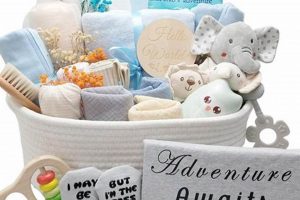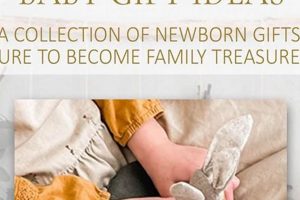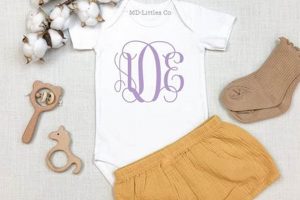Items imbued with religious significance, often presented to newborns or infants, serve as tangible expressions of faith and hope for the child’s spiritual journey. These tokens can range from devotional objects, such as rosaries or crucifixes, to personalized keepsakes featuring biblical verses or symbols representative of the family’s religious tradition. For example, a baptismal gown passed down through generations or a framed print of a cherished religious image would qualify.
The practice of offering religiously themed presents to babies carries considerable weight within various faiths. It provides a means to formally welcome the child into the religious community and introduce them to its values and beliefs. Furthermore, these objects can serve as constant reminders of faith throughout the child’s upbringing, fostering a sense of belonging and spiritual connection. Historically, such presents have been viewed as protective charms or blessings, intended to safeguard the child’s well-being and guide them toward a virtuous life.
This article will explore the diverse range of faith-based items suitable for infants, considering factors such as religious denomination, personalization options, safety standards, and appropriate occasions for presentation. The intention is to provide guidance in selecting meaningful and respectful presents that align with the family’s beliefs and contribute positively to the child’s spiritual development.
Selecting Faith-Based Infant Presents
The selection of items imbued with religious significance for newborns or infants requires careful consideration to ensure appropriateness, safety, and alignment with the family’s beliefs. The following tips provide guidance in navigating this process.
Tip 1: Religious Denomination Alignment: Ascertain the specific religious tradition of the recipient’s family. Presents should be consistent with their beliefs and practices. Presenting a Christian baptismal gown to a Jewish family would be inappropriate, for example.
Tip 2: Safety Standards: Prioritize the safety of the infant. All items, especially those intended for direct contact (e.g., plush toys with religious symbols), must adhere to established safety standards. Avoid small parts that could pose a choking hazard.
Tip 3: Age Appropriateness: Choose items suitable for the infant’s developmental stage. A delicate, antique rosary, while beautiful, is not an appropriate present for a baby who is teething and likely to put it in their mouth.
Tip 4: Durability and Quality: Select presents crafted from durable materials that can withstand regular use and cleaning. Consider items made from organic or sustainable materials to minimize potential exposure to harmful chemicals.
Tip 5: Personalization Options: Explore personalization options to make the present more meaningful. Engraving the child’s name and date of birth on a silver cross or embroidering a biblical verse on a blanket adds a personal touch.
Tip 6: Consultation with Family: If uncertain about appropriate presents, consult directly with the family. This ensures the selected item is welcomed and aligns with their preferences.
Tip 7: Occasion Appropriateness: Consider the occasion for which the present is being given. Baptismal presents differ from those given at birth or during other religious holidays.
These considerations ensure that the selected items serve as meaningful expressions of faith and provide a positive and safe experience for the infant. Thoughtful selection fosters a sense of connection to the family’s religious heritage from an early age.
This guidance should aid in the thoughtful selection of faith-based items, ensuring their appropriateness and lasting significance for the child and their family.
1. Denomination Specificity
Denomination specificity is a crucial component when selecting faith-based infant presents. Failure to consider the recipient’s specific religious tradition can result in the selection of items that are inappropriate or even offensive. Presents that do not align with the family’s beliefs may be perceived as disrespectful or lacking in understanding, potentially causing unintended offense. For example, gifting a statue of the Virgin Mary to a Jewish family would be unsuitable due to the differing theological views and practices of the two religions. Similarly, a present featuring images of the Prophet Muhammad would be inappropriate for many Christian families.
The practical significance of understanding denomination specificity lies in ensuring that the presents are meaningful and contribute positively to the child’s spiritual development within their specific faith tradition. In Christian traditions, for instance, a baptismal gown, a cross necklace, or a children’s Bible are commonly given presents. For Jewish families, a silver Kiddush cup, a dreidel for Hanukkah, or a book of Jewish prayers are often favored. Understanding these nuances allows for the selection of presents that are both appropriate and appreciated, reflecting the giver’s thoughtfulness and respect for the family’s beliefs. Consultation with family members or religious leaders can further clarify appropriate presents within a given denomination.
In summary, denomination specificity is an indispensable consideration in the realm of faith-based infant presents. Neglecting this aspect can lead to the selection of items that are inappropriate or even offensive. A thorough understanding of the recipient’s religious tradition is essential for ensuring that the selected items are meaningful, respectful, and contribute positively to the child’s spiritual development. Prior research or direct consultation with the family is encouraged to navigate the complexities and ensure a thoughtful and appropriate present selection.
2. Safety and Suitability
The intersection of safety and suitability with religious infant items demands meticulous attention. The inherent vulnerability of infants necessitates that presents, regardless of their symbolic or religious value, adhere to stringent safety standards. Failure to prioritize safety can have severe consequences, transforming a well-intentioned present into a hazard. Small parts, toxic materials, or poorly constructed items can pose choking, poisoning, or injury risks. Therefore, understanding the direct causal relationship between present selection and infant well-being is paramount. For example, a rosary with easily detachable beads presents a significant choking hazard. Similarly, a plush toy made with non-hypoallergenic materials could trigger allergic reactions. Therefore, religious presents must comply with relevant safety regulations and certifications.
The practical application of this understanding involves careful evaluation of presents prior to purchase. Inspection for small, detachable parts, sharp edges, and potentially harmful chemicals is essential. Labels indicating compliance with safety standards, such as ASTM International or CPSIA, provide assurance. When choosing clothing, organic cotton and non-toxic dyes are preferable. Parents and caregivers should also be educated about potential hazards associated with specific items. For instance, informing parents about the proper use of a baby-safe menorah during Hanukkah, ensuring it is kept out of reach and never left unattended, demonstrates a commitment to both religious tradition and child safety. Selection goes beyond mere religious significance; it demands a rigorous assessment of potential risks and benefits.
In summary, the imperative of safety and suitability cannot be overstated in the context of religious infant items. Prioritizing these factors mitigates potential risks and ensures that presents contribute positively to the child’s well-being. The challenge lies in balancing the desire to impart religious values with the responsibility to protect infant health and safety. A comprehensive approach that combines thoughtful selection, adherence to safety standards, and parental education is essential for creating a safe and nurturing environment for the child’s spiritual and physical development.
3. Symbolic Representation
Symbolic representation forms the core of many faith-based infant presents, imbuing seemingly simple items with deeper meaning and significance. The choice of symbols transcends mere aesthetics; it serves as an early introduction to the core tenets and values of the family’s religious tradition. The presence of such symbols can have a profound effect, creating a tangible connection to faith from the earliest stages of life. A cross, for instance, represents the sacrifice and salvation central to Christian belief. A Star of David symbolizes Judaism and the covenant between God and the Jewish people. A carefully chosen religious image, verse, or color can convey layers of meaning related to faith, hope, and love. The absence of accurate or meaningful symbolism negates the value of the present as a vehicle for religious expression and education.
The practical significance of understanding symbolic representation manifests in the informed selection of presents. For instance, an infant’s blanket embroidered with verses from scripture becomes more than just a source of warmth; it transforms into a constant reminder of faith and a source of comfort. A mobile featuring religious symbols, carefully placed above a crib, provides visual stimulation while subtly introducing religious iconography. Selecting presents that feature symbols relevant to the specific occasion, such as a baptismal gown with a dove emblem or a Hanukkah-themed mobile, further enhances their appropriateness and meaning. In contrast, presents with generic religious imagery, or symbols inaccurately representing the family’s beliefs, fail to convey the intended message and may even be viewed as disrespectful.
In conclusion, the judicious use of symbolic representation is paramount in selecting religious infant presents. This element transforms an object into a powerful communicator of faith, hope, and tradition. Ensuring the symbols are accurate, meaningful, and appropriate for both the religious tradition and the specific occasion elevates the present beyond mere material value. The key challenge lies in balancing aesthetic appeal with theological accuracy, ensuring the presents serve as both beautiful keepsakes and valuable instruments for early religious instruction. A strong understanding of symbolic representation is therefore vital in facilitating the child’s initial connection with the familys faith.
4. Personalized Blessings
Personalized blessings, when integrated into religious items for infants, significantly enhance their emotional and spiritual resonance. The addition of individual elements transforms a generic present into a cherished keepsake, imbued with specific hopes and prayers for the child’s future. This personalization links the religious significance of the item directly to the infant, creating a unique and lasting connection to faith.
- Engraved Inscriptions
Engraved inscriptions, such as the child’s name, date of birth, or a meaningful scripture verse, add a layer of intimacy to religious items. For example, a silver cross engraved with the child’s name and baptismal date becomes a permanent reminder of this significant religious milestone. These inscriptions transform mass-produced items into unique symbols of faith, tailored specifically for the child’s spiritual journey.
- Customized Prayers or Dedications
The inclusion of a customized prayer or dedication provides a bespoke blessing directly relevant to the child and family. A prayer written by a grandparent and embroidered onto a blanket or printed on a framed artwork reflects the family’s specific hopes and wishes for the infant’s life. This bespoke element fosters a deep sense of connection and spiritual nurturing, offering comfort and guidance as the child grows.
- Symbolic Embellishments Reflecting Family Heritage
Adding symbolic embellishments that reflect the family’s religious heritage personalizes the present in a culturally relevant manner. Incorporating traditional religious symbols or motifs unique to the family’s background enriches the item’s meaning and strengthens the child’s connection to their ancestral faith. This customization recognizes and celebrates the family’s unique religious identity, passing down traditions through generations.
- Selection of Scriptures or Religious Texts
Selecting specific scriptures or religious texts that resonate with the family’s values personalizes a gift. Rather than a generic religious verse, choosing a passage that holds particular significance creates a tailored connection. Including this text on items such as wall art or keepsake boxes provides ongoing inspiration and a reminder of the family’s core beliefs.
The integration of personalized blessings into religious items elevates these presents beyond mere objects. They become powerful expressions of faith, love, and hope, tailored specifically for the infant and their family. This personalization strengthens the child’s connection to their religious heritage and provides a lasting source of spiritual comfort and guidance throughout their life, reinforcing the item’s value as a cherished religious keepsake.
5. Educational Value
The educational value inherent in presents infused with religious significance for infants extends beyond mere entertainment. Such items offer an early introduction to the foundational narratives, moral teachings, and cultural traditions associated with the family’s faith, laying the groundwork for future religious understanding and engagement. The thoughtful selection of faith-based items can serve as a catalyst for cognitive and spiritual development from a very young age.
- Early Introduction to Religious Narratives
Infant-friendly versions of religious stories, conveyed through board books, picture books, or even fabric books, provide an accessible entry point to foundational religious narratives. Illustrations and simplified text enable infants to become familiar with key figures, events, and moral lessons, fostering early recognition and engagement with the religious tradition. This exposure, while rudimentary, establishes a base for future learning and comprehension.
- Moral Development Through Religious Teachings
Many faith-based items subtly impart moral teachings through rhymes, songs, or symbolic representations. Presents featuring themes of kindness, compassion, forgiveness, and love introduce fundamental ethical concepts within a religious framework. These early exposures shape the child’s understanding of right and wrong, influencing their moral development and fostering a sense of empathy and social responsibility. Religious building blocks with images of different people showing kindness are a good example for this part.
- Familiarization with Religious Symbols and Rituals
Faith-based items depicting religious symbols, such as crosses, Stars of David, or menorahs, allow infants to become acquainted with these visual representations of faith. Similarly, presents that subtly incorporate aspects of religious rituals, such as a baby-safe Kiddush cup or a toy shofar, expose them to these practices from an early age. This familiarization can foster a sense of comfort and belonging within the religious community.
- Cultural Transmission of Religious Traditions
Religious presents often reflect specific cultural traditions associated with the family’s faith. Items such as traditional clothing, holiday-themed toys, or books featuring cultural stories transmit the cultural heritage of the religious community. This exposure to cultural practices helps the infant develop a sense of identity and connection to their cultural roots, fostering a deeper appreciation for their religious heritage.
The educational facets inherent in faith-based presents for infants collectively contribute to the child’s holistic development, nurturing their cognitive, moral, and spiritual growth. These items, when carefully selected, transform from mere presents into valuable instruments for early religious education and cultural transmission. Through such engaging and age-appropriate methods, the seeds of faith are sown early, shaping the child’s understanding and appreciation of their religious heritage.
Frequently Asked Questions
This section addresses common inquiries concerning the selection, appropriateness, and safety of items intended to convey religious significance to infants.
Question 1: What constitutes an appropriate religiously themed present for a newborn?
Appropriateness is dictated by the recipient family’s specific religious denomination, adherence to safety standards, and suitability for the infant’s developmental stage. Items should align with the family’s beliefs and practices, be free from potential hazards, and be designed for infant use.
Question 2: How can one ensure the safety of religiously themed presents intended for infants?
Safety is paramount. Presents should comply with relevant safety standards and certifications. Small, detachable parts, sharp edges, and potentially toxic materials must be avoided. Items should be constructed from durable, non-toxic materials and regularly inspected for damage.
Question 3: Is it appropriate to give presents representing a different religious tradition?
Generally, it is not advisable to give presents representative of a religious tradition differing from that of the recipient’s family. Such presents may be misinterpreted as disrespectful or lacking in understanding of the family’s beliefs.
Question 4: What is the significance of personalization in religiously themed presents?
Personalization enhances the emotional and spiritual value of the present, transforming it from a generic item into a cherished keepsake. Engravings, customized prayers, or symbolic embellishments that reflect the family’s religious heritage create a unique and lasting connection to faith.
Question 5: Are there specific occasions more suitable for presenting religiously themed presents?
Certain occasions, such as birth, baptism, christening, or religious holidays, are particularly appropriate for presenting religiously themed presents. The occasion should align with the present’s symbolism and religious message.
Question 6: How does one balance religious expression with practicality when selecting presents for infants?
The ideal present balances both religious significance and practicality. Select items that are both meaningful expressions of faith and useful in the infant’s daily life. For example, a blanket embroidered with a religious verse combines comfort with spiritual significance.
Careful consideration of these factors will ensure the selection of thoughtful, appropriate, and safe presents that contribute positively to the infant’s spiritual development and the family’s religious traditions.
This concludes the frequently asked questions. The following section will discuss the etiquette involved.
Concluding Thoughts on Religious Baby Gifts
This exploration of items imbued with religious meaning for infants has illuminated key aspects surrounding their selection and significance. The importance of aligning presents with the recipient’s denomination, ensuring safety and suitability, understanding symbolic representation, incorporating personalized blessings, and recognizing the educational value has been underscored. These factors contribute to the selection of items that are not only appropriate but also meaningful and beneficial to the child’s spiritual development.
As families welcome new members into their religious communities, the thoughtful selection of faith-based presents remains a powerful way to express love, hope, and commitment to the child’s spiritual well-being. By carefully considering the principles outlined, individuals can contribute to the creation of a nurturing environment where faith can flourish from the earliest stages of life, ensuring that these religiously significant items serve as lasting reminders of love, faith, and divine blessings throughout the child’s journey.







